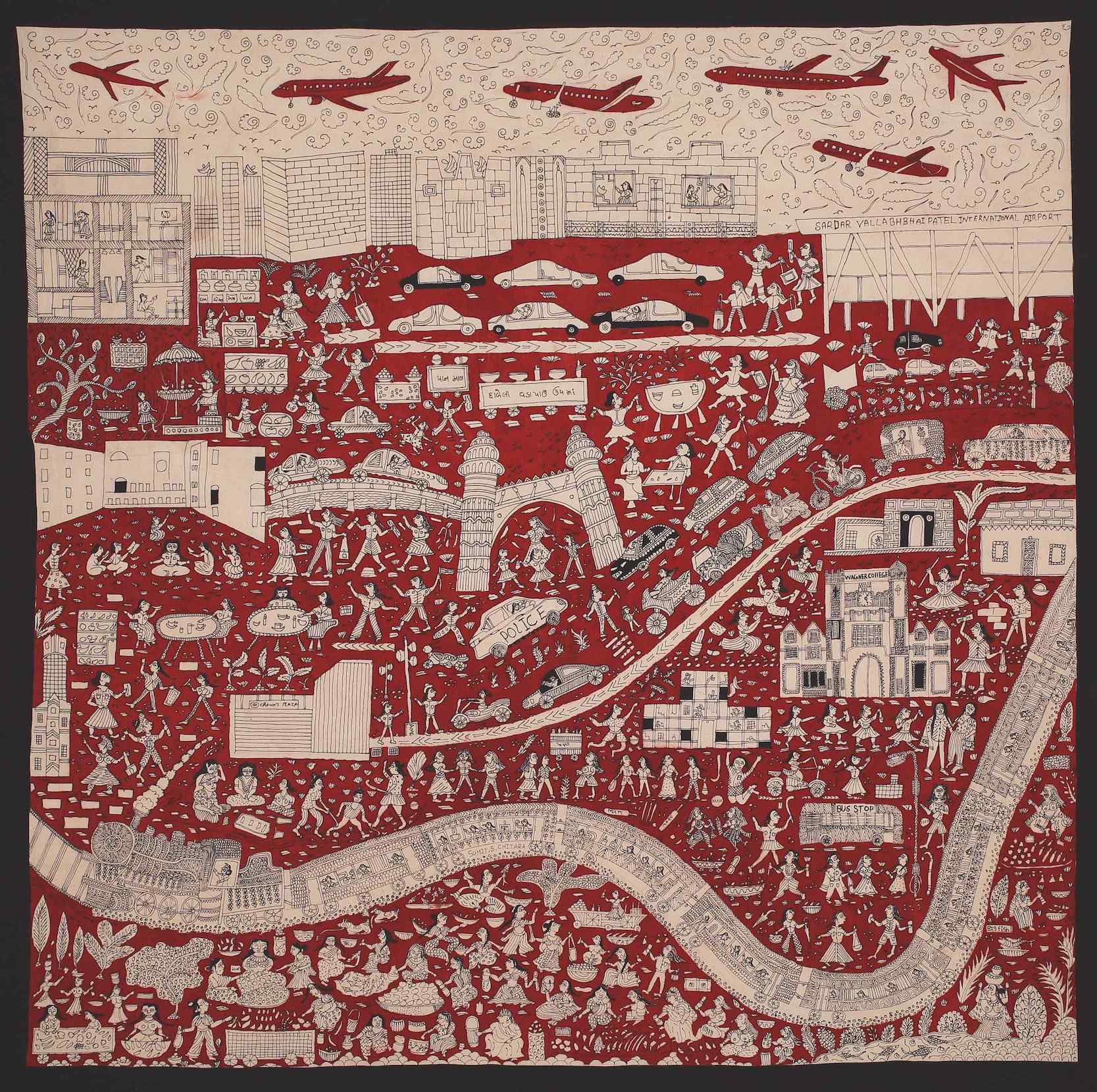
Image: Cityscape, Ahmedabad, 2020, Sanjay Chitara & Sumit Chitara, Mata-ni-Pachedi @ Sarmaya Arts Foundation (2020.17.1)
“Gujaratis delight in bringing everything down to earth, you know? There’s a deflating quality about their humour. So even though you have these magnificent monuments, the painting has a tongue-in-cheek, slightly irreverent quality.”
Amrita Shah is a journalist and the author of Ahmedabad: A City In The World. The same year that she finished writing the book—2013—Gujarat’s charismatic Chief Minister threw his hat in the ring for the job of Prime Minister. As a veteran political journalist of decades, Shah already sensed which way the wind was blowing. And she wanted to tell the story of that moment through the lens of one historic city.
Shah likes historian Howard Spodek’s description of Ahmedabad as a ‘shock city’. The political, social and cultural movements born here have impacted the whole country—from Mahatma Gandhi’s experiments with political mobilisation to the growth of the textile industry to the launch of India’s space program. Nor is this just a 20th-century phenomenon.
“Ahmedabad had a very wealthy class of people who were kingmakers since the Mughal times,” says Shah. “It has very strong entrepreneurial class. A bureaucrat once said to me, ‘[Ahmedabadis] will try anything once’. Gujarat has the longest coastline in the country, and Ahmedabad had a route to the sea. As an important point on the trade route, it saw a constant stream of merchants passing through.” All these factors have coalesced to create the city’s vivid personality.
In her book, Shah shows us around Ahmedabad through a compelling blend of personal narratives and political histories. In her very granular portraits of regular Ahmedabadis, from the displaced to the ascendant, we see clearly how the past imposes on the present. As a Gujarati, albeit from Mumbai, Shah slips comfortably into the rhythms of the city.
In this feature, Amrita Shah shows us around her Ahmedabad through a landscape painted by two artists who call the city home. Sanjay Chitara is a National Award-winning artist of the Mata-ni-Pachedi tradition. Sumit is his son and he experiments with the form to create contemporary works that reflect the city that he has inherited: the 21st-century Ahmedabad of soaring planes and speeding autos.
So let’s hail an auto and follow Amrita, Sanjay and Sumit along these painted roads to get to the heart of Ahmedabad.
Tap on the links to jump ahead and read about: Old City, Ahmedabad's autos, Sabarmati, Bhadra Fort, women of Ahmedabad, Sarkhej-Gandhinagar Highway, and Sardar Vallabhbhai Airport.
Chugging into Old City
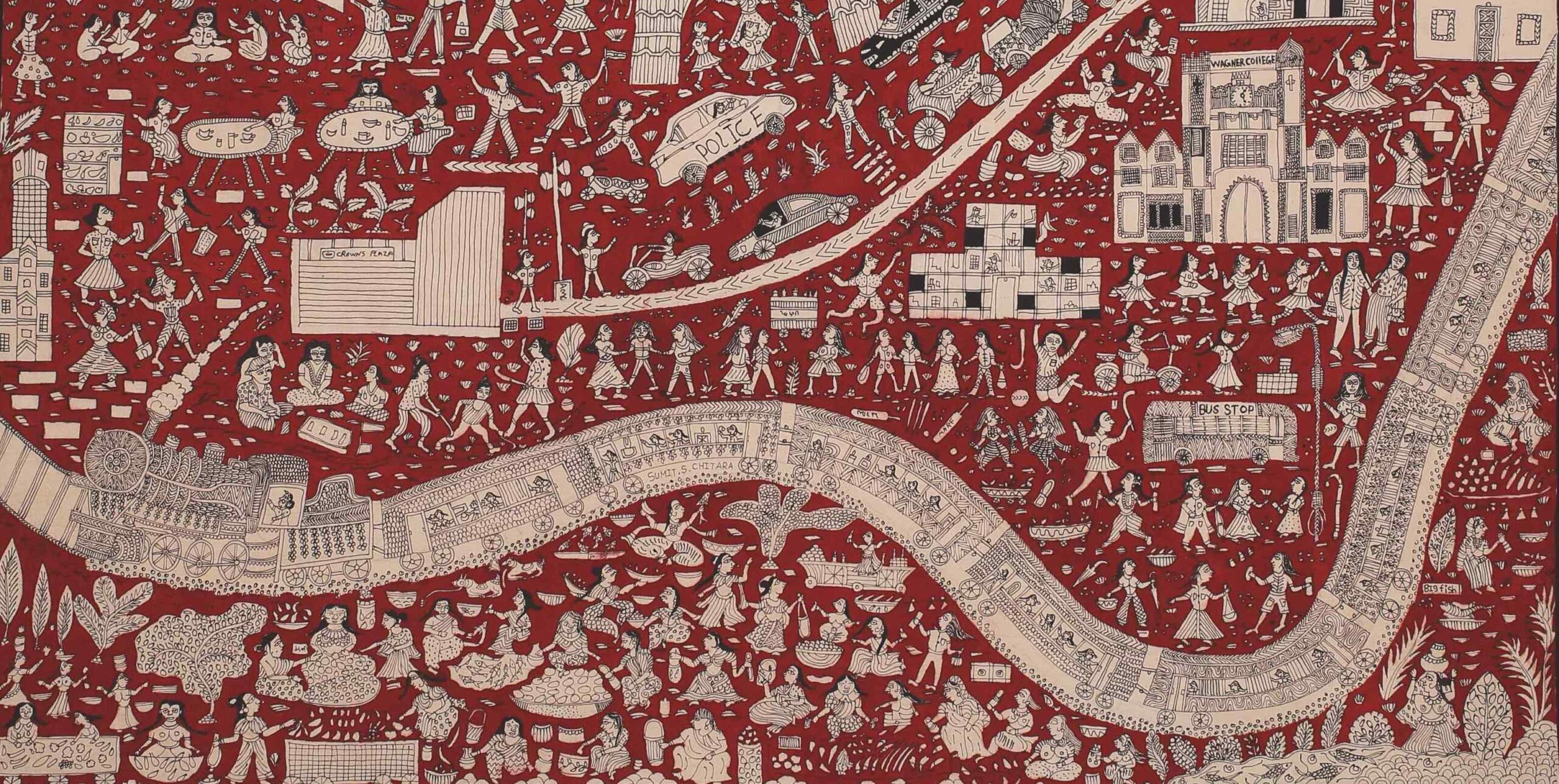
“To me the most striking thing about this painting is the train. The long-winding train is painted like the Sabarmati river that runs through the city. As a frequent visitor to the city, I’m very familiar with the points of entry into the city. I would take the Shatabdi from Mumbai, which left early in the morning and arrived in Ahmedabad in the early afternoon. And Kalupur station is in the Old City. It’s a very very busy station, bustling with crowds and energy.”
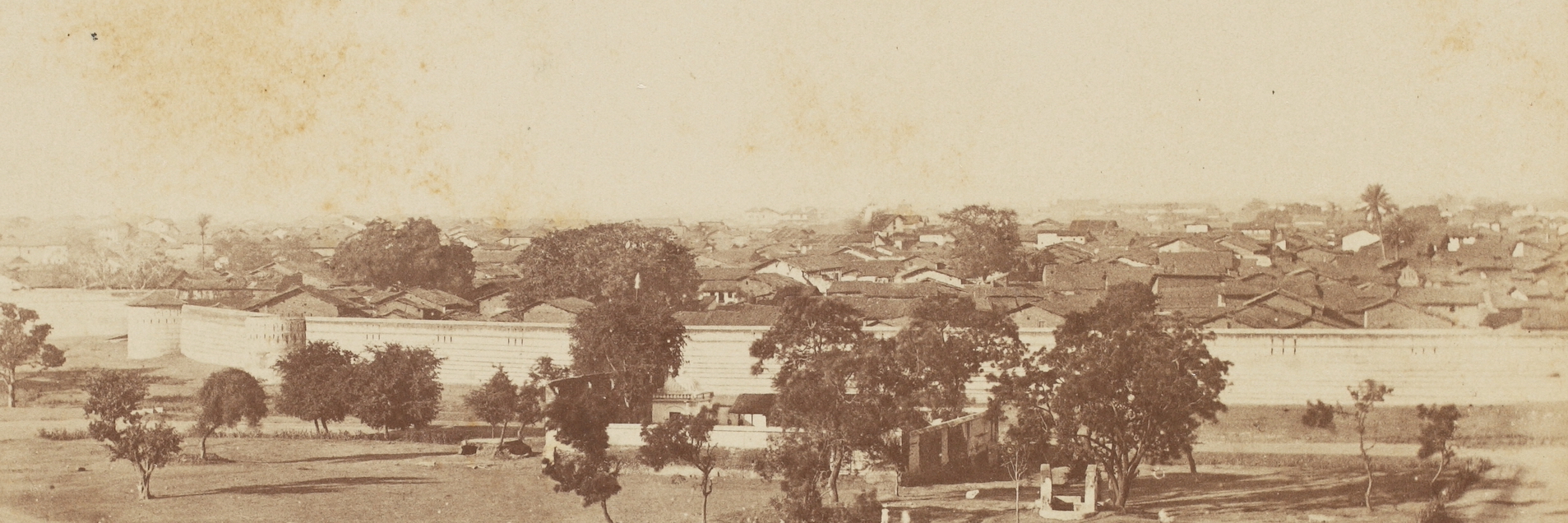
Image: Walls of the Old City, Ahmedabad, photo from ‘Architecture At Ahmedabad, The Capital of Goozerat’, 1866, by Theodore C Hope, James Fergusson, John Murray @Sarmaya Arts Foundation (2016.30.8)
Ahmedabad's autos
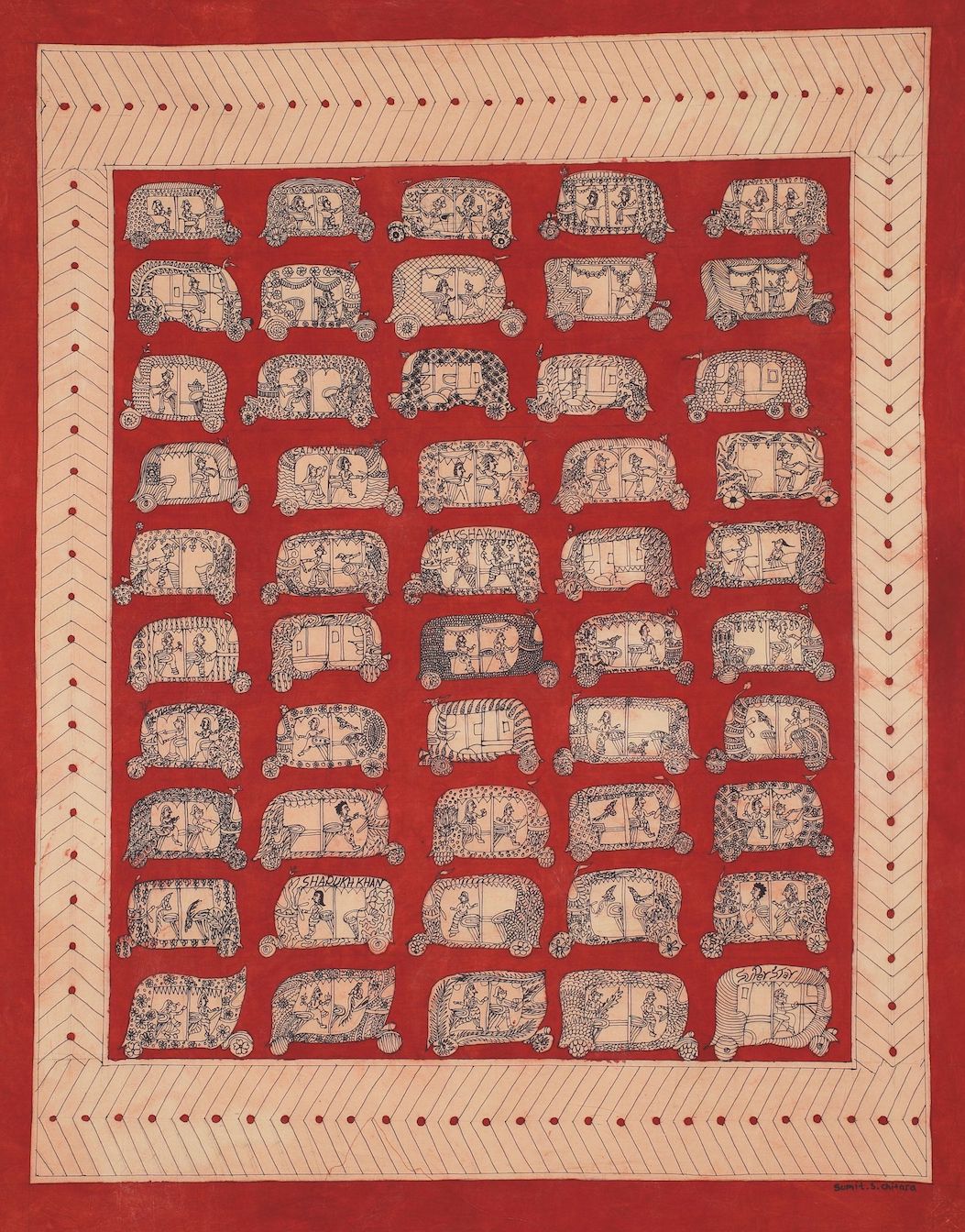
Image: Auto Rickshaw, Contemporary chandarvo by Sumit Chitara, Natural colours on textile, 2019 © Sarmaya Arts Foundation (2019.46.1)
“The autorickshaw is the best way to get around Ahmedabad, particularly in the old city. At one point, Ahmedabad used to be extremely polluted and one of the sources of pollution was the autorickshaw. But they adopted CNG quite early. A driver once said to me, pointing to the green-and-yellow CNG autos, ‘Look at them, like poppats (parrots).’”
Sabarmati
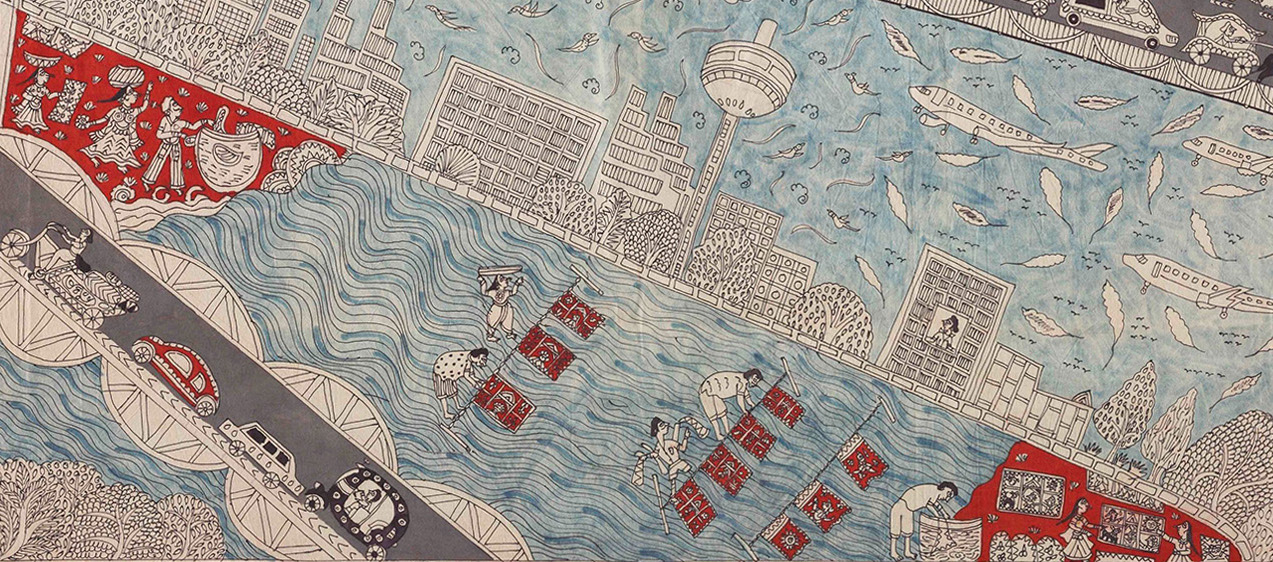
“If you look at a map, Ahmedabad is a rough circle with the river dividing it into almost equal halves. And the river is the reason Ahmed Shah founded the city in 1411. The earlier capital, Anhilwad-Patan, had run out of water. There’s a story that Ahmed Shah was out on a hunt and resting by a riverbank when he saw a hare chasing his hounds. That made him think that this must be a place with remarkably bold inhabitants, so he decided to make the place the site of his new capital. Ahmedabadis hold this story to be central to the city’s identity but I have since come across this story in other places. So I imagine it applied more generally to symbolise resistance to central authority. This applied to Ahmedabad because Ahmed Shah was the heir of Muzaffar Shah, who broke away from the Delhi Sultanate to rule Gujarat independently in 1407. I think Ahmedabad and Gujarat embody the sense of self-assertion that this myth communicates.”
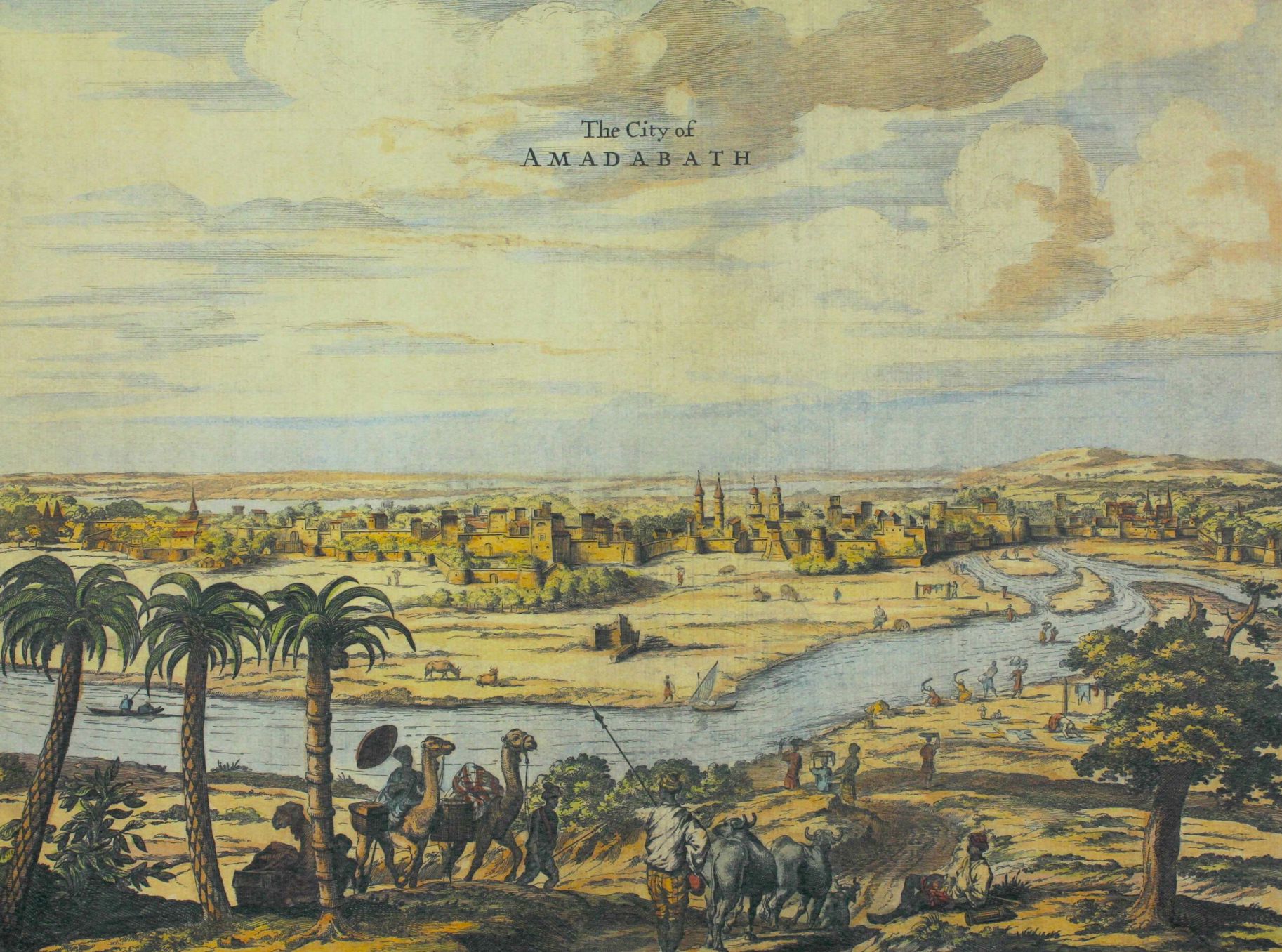
Image: Ahmedabad, engraving 1682, Phillipus Baldaeus @ Sarmaya Arts Foundation (2015.3.58)
“At some point in Ahmedabad, you will invariably come to the Sabarmati. A sudden moistness in the air—for me, this was a clear sign that I was in Ahmedabad and nowhere else. The Sabarmati begins in the Aravalli, which are rich in rose quartzite. Perhaps why the sand next to the river had this very particular pinkish quality.”
“The river is dry most of the year. But it’s also very temperamental so it’s liable to flood and cause widespread destruction in the rains. In a way, it’s very much like the city. Ahmedabad has a reputation for very calm, pragmatic people but it also has a reputation for being the site of the most violent and brutal mass riots. So I guess the river mirrors that temperamental nature.”
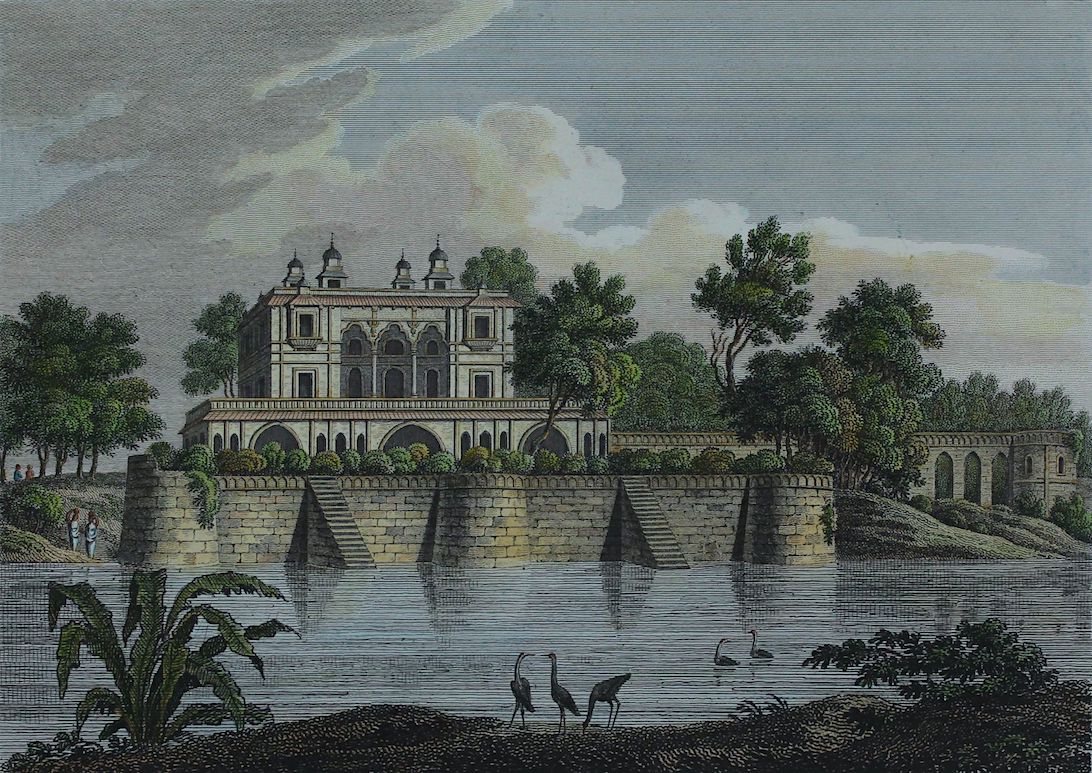
Image: 'The Shah Bhaug, a Summer Palace built by the Emperor Shah Jehan, on the banks of the Sabermatty', 1834, engraving by J. Storer © Sarmaya Arts Foundation (2015.3.37)
“Now of course, the banks of the Sabarmati have been concretised under the Sabarmati Riverfront Project. And the river itself has been levelled and filled with water gotten from miles away. The people who live by the river have been moved out. This model has been copied in other cities in India, but it’s an idea of development and urban beautification that I find extremely troubling.”
Bhadra Fort
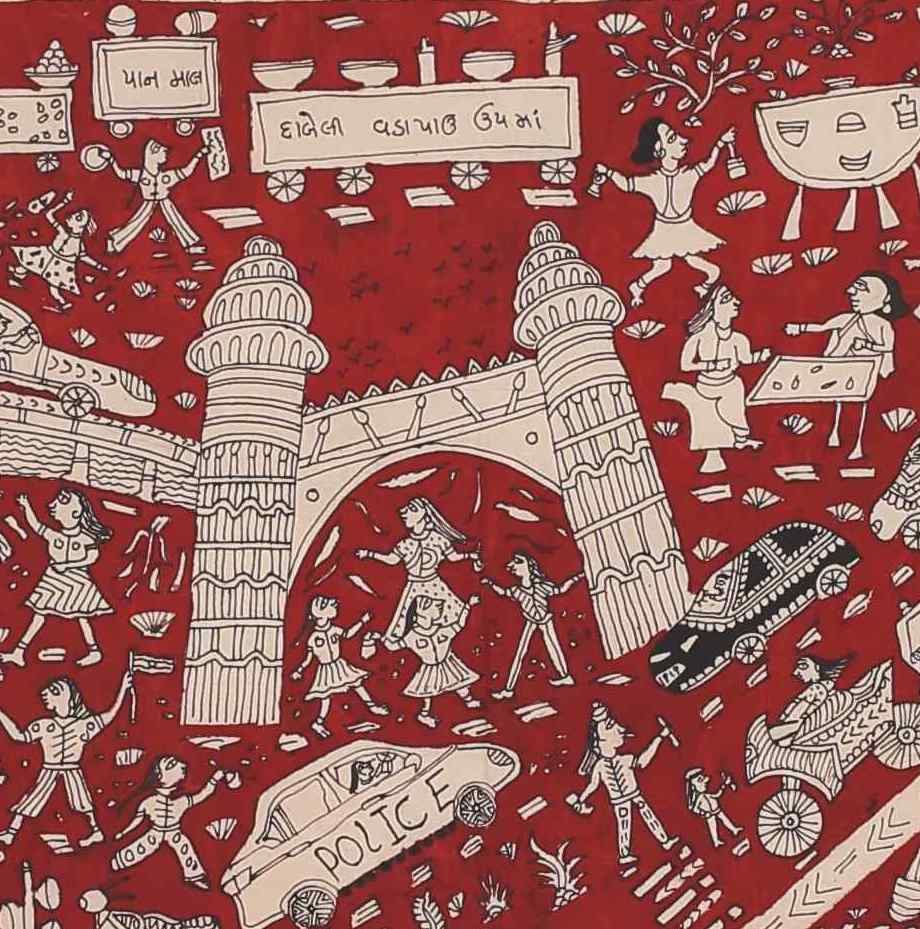
“There’s this archway you see at the end of the bridge, which I’m assuming indicates the Sabarmati. Ahmedabad has many gates as part of the old fortifications. But the gate here I’m assuming is the Bhadra [Fort], named for the Rajput citadel of that name in Patan, the old capital of Gujarat. This is the oldest fortification erected by Ahmed Shah soon after the city was founded in 1411. It is very grand and solid. It’s not as imperious as Mughal architecture but in its own austere way, it has a certain solidity and grandeur about it.”
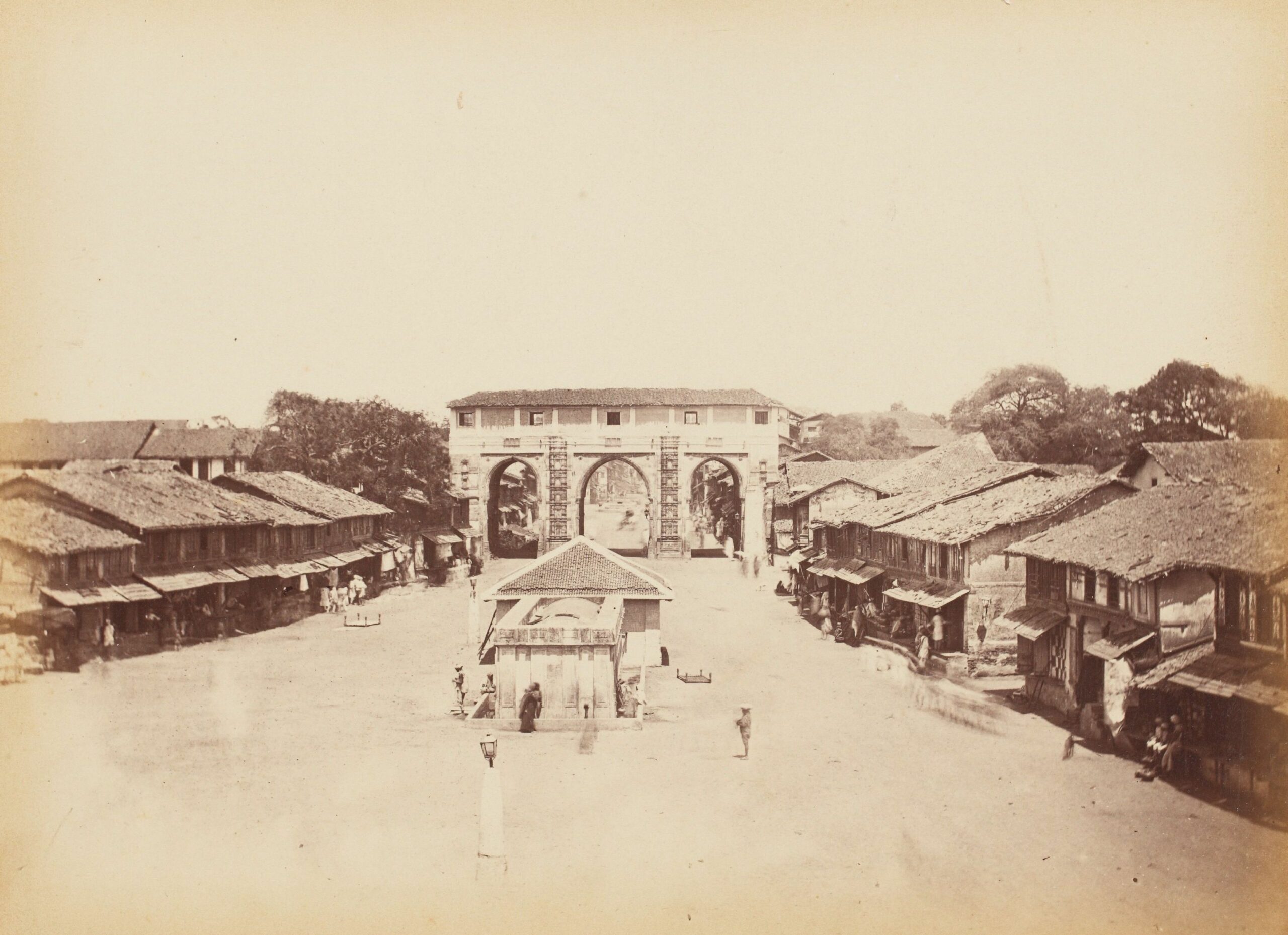
The Teen Darwaza is the eastern gateway of the citadel of the Bhadra Fort. Photo of Teen Darwaza, Ahmedabad, Gujarat, c. 1850s, Thomas Biggs © Sarmaya Arts Foundation (2016.1.42)
Women of Ahmedabad
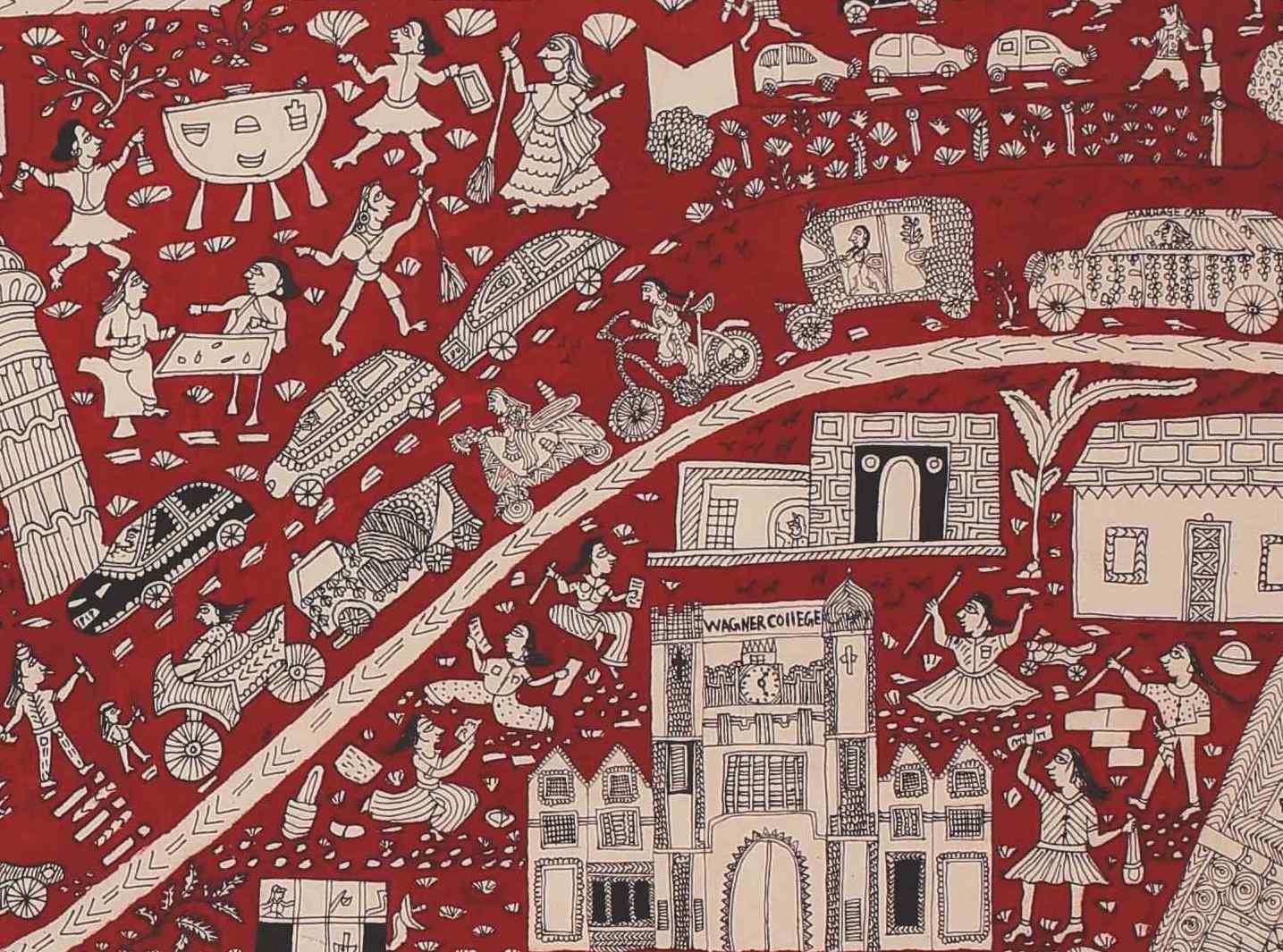
“I’m coming now to the ubiquitous presence of women in the painting. Obviously it’s a Mata-ni-Pachedi painting so women do occupy a central place in it. You see women dancing, moving about, driving on two-wheelers, they are of all classes, wearing different things. This is very much a characteristic of Ahmedabad. It is considered very safe for women, certainly safer than most other cities in the country. Possibly because it was a centre of textile manufacture with shifts running late into the night. And many women worked in the mills also. So you had busy streets at all times and so woman were safe. There’s an openness to women studying, working and moving about. A very common sight in Ahmedabad in young girls on scooters with their heads covered with chunnis just to keep out the smoke and dust.”
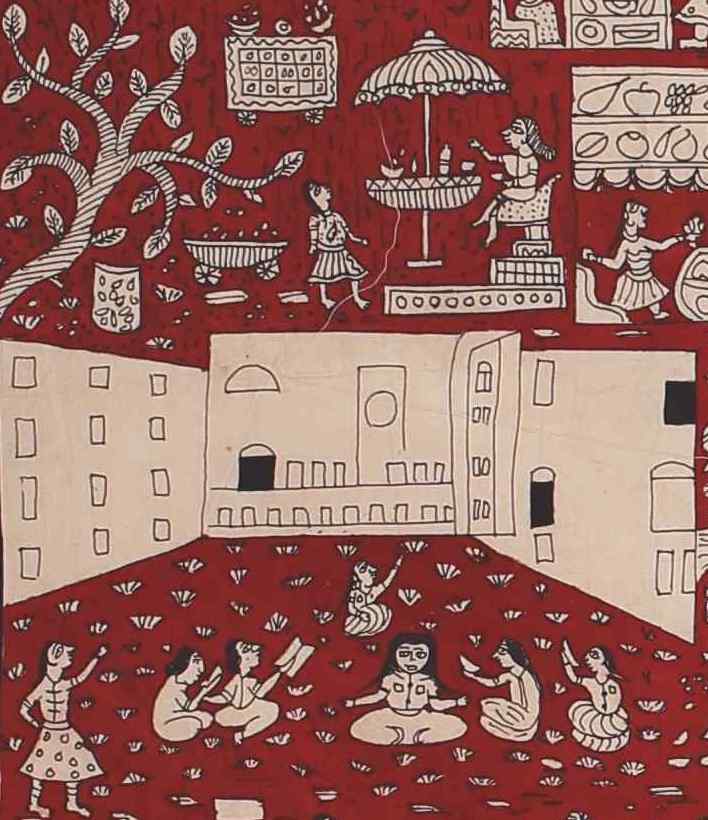
“Traditionally, the many NRGs (Non-Resident Gujaratis) and the comings and goings of people from abroad added to that feeling of greater (relative) openness towards women’s emancipation. Lately, I’ve been hearing of trends that are not as positive for women. Domestic violence, and policing of young single women who are studying or working here. That doesn’t bode well for a city with a reputation for openness.”
Sarkhej-Gandhinagar highway
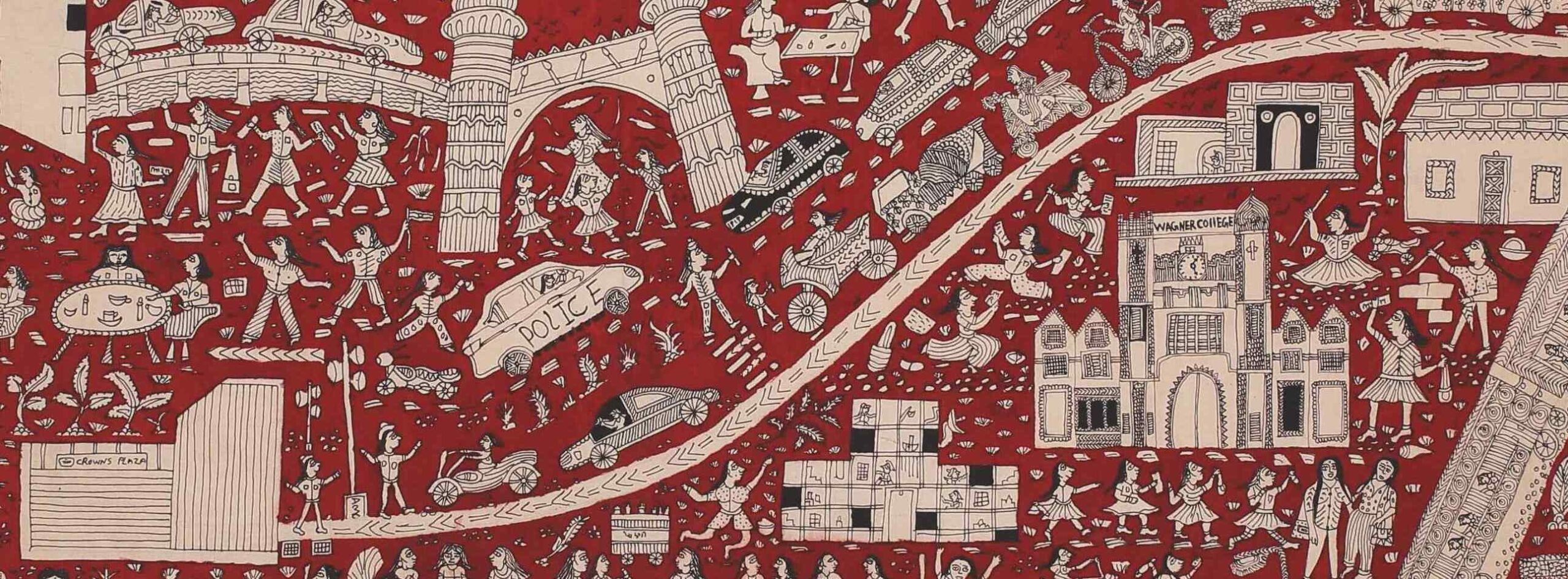
“At the centre of the painting you see an angular building with Crowne Plaza written on it. And a ribbon unfurling from it—this seems to be Sarkhej-Gandhinagar highway, which used to be at the margins of the city, maybe two decades ago. But as the city advanced to the west, it’s become a very central and important strip. It runs from Sarkhej, the centre-point of which is the Sarkhej Roza, which is a large historical complex built around the tomb of the much revered Sufi saint Shaikh Ahmed Khattu Ganj Bakhsh. Some of Gujarat’s sultans including Mohammed Begda are also buried there. It has beautiful trellis work and the way the light filters through it is truly poetic. At the other end you have Gandhinagar, which is the capital of Gujarat. It’s a planned city built in the post-Independence era like Chandigarh and Bhuvaneshwar. It’s a very modern city. One of the landmarks there is the ornate Akshardam Temple of the Swaminarayan sect.”
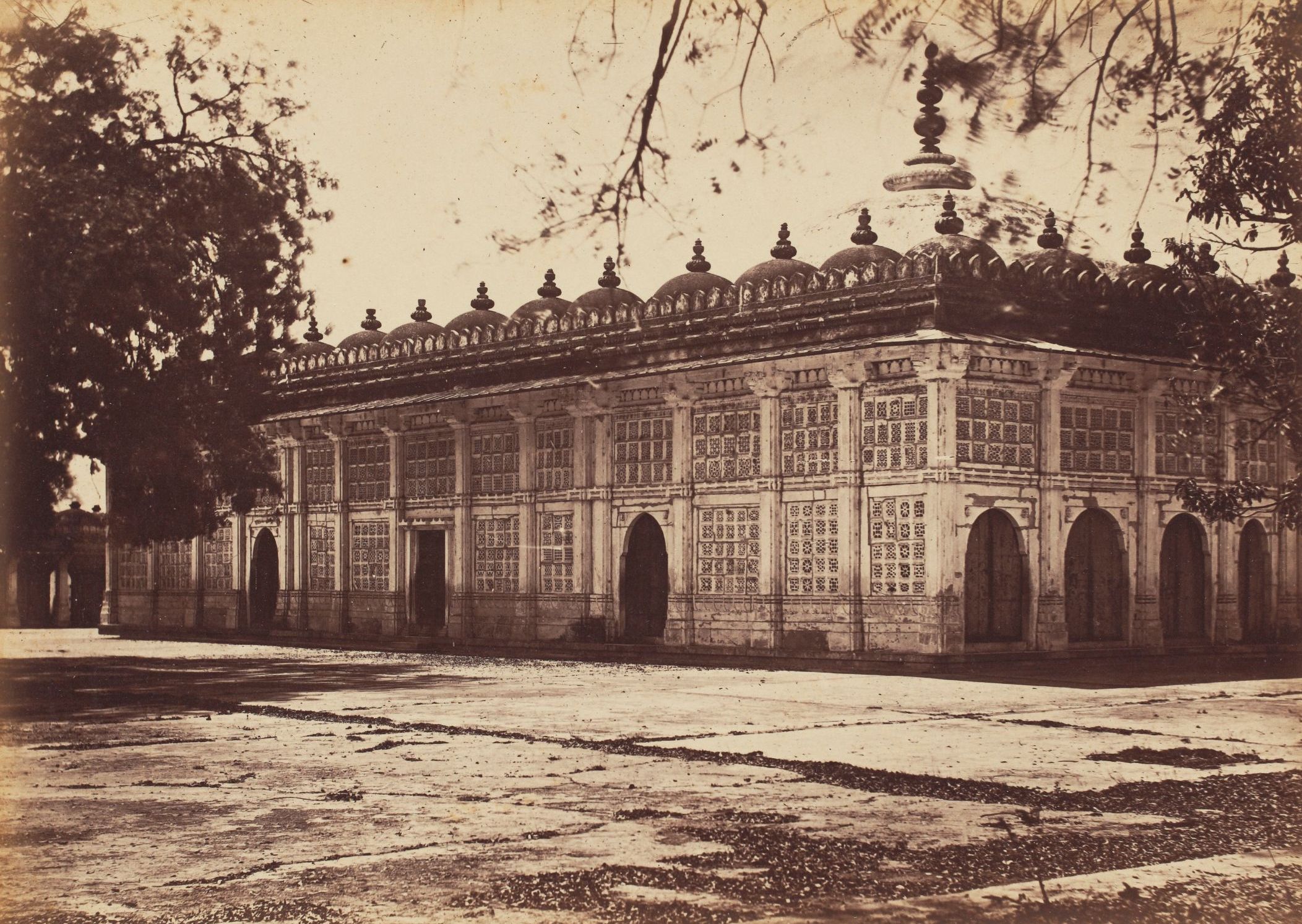
The tomb of Gunj Buksh at Sarkhej Roza, Ahmedabad, photo from 'The Architecture at Ahmedabad, the Capital of Goozerat', 1866 @ Sarmaya Arts Foundation 2019.47.3 (1)
Sardar Vallabhbhai Airport

“Right on top is the Sardar Vallabhbhai Airport, India’s seventh busiest airport handling over 10 million passengers annually. So these many planes that the artist has drawn right on top, almost like birds or clouds in the sky, is very apt. Gujaratis are settled all over the world and there are direct flights to London, Singapore, Jeddah, Dubai. Food is important to Gujaratis and you see that in the stalls scattered all over the painting. At the airport, you get very good masala chai and expertly sealed snacks that you can keep for many, many weeks. Just like, I assume, the merchant seafarers in the past used to carry dry snacks on their long journeys abroad.”



